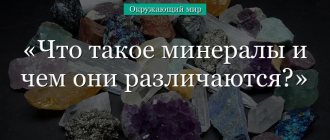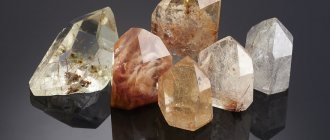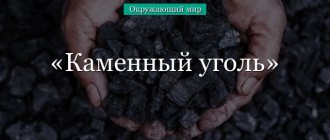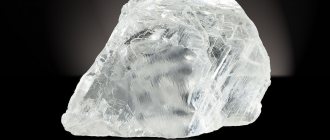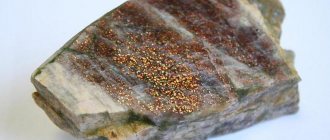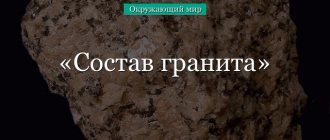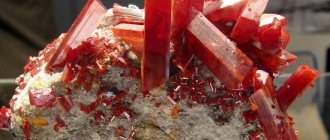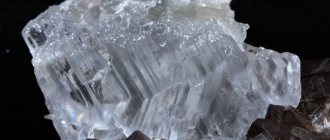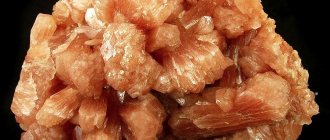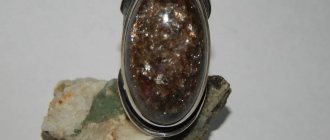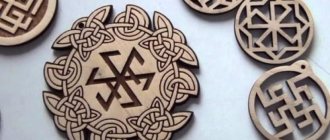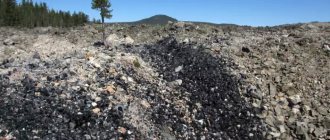- Reports and messages
- Geography
- Mica is a mineral
Mica is a mineral whose distinctive feature is its layered structure.
This is a fairly common mineral. Mica can be cut into very thin sheets and are quite flexible and durable. Metal impurities (iron, manganese, chromium) in mica provide its different colors. It comes in brown and green, as well as black and pink in various shades. This mineral is mined by open or underground methods. Mica is part of rocks of volcanic origin. The largest mica deposits are located in India, Brazil, the USA, and there is a lot of this mineral in Madagascar and Russia.
This mineral was known and highly valued in ancient Egypt, it was discovered in the pyramids. Later, mica began to be used in windows and lamps, in decorating churches and making icons, decorating boxes and caskets. Mica lanterns with candles inside were very popular, because this material is transparent and heat-resistant, such lamps were inexpensive. At one time, mica competed with glass and won due to its lower price and ease of manufacturing plates, because for this mica only needed to be thinly sliced.
Mica is used in electrical engineering due to its excellent insulating properties, as well as for the production of special optical glasses and in radiation measuring instruments. Mica chips applied to paper are used as an insulating material. Expanded and burnt mica is vermiculite. Its scope of application is a filler for concrete, insulation, and sound insulation. Vermiculite is added to the soil by gardeners, especially for indoor plants, to loosen it. Individual layers and parts of mica can be glued together to produce mica plastic. The finest dust from the mineral is added to cosmetics to give them shine, as well as to paints and varnishes.
Brief information about mica
Mica is part of igneous and altered rocks. There are varieties of mica that differ in composition and color.
| Mica name | Metals in the composition | Color |
| Muscovite | Aluminum | Absent in the plate, gray in the layer |
| Phlogopite | Magnesium | Green, green-brown |
| Biotite | Magnesium, iron | Black, brown |
| Vermiculite | Magnesium, iron | Golden yellow, yellowish brown |
| Lepidolite | Lithium | Lilac, pink |
Rice.
1. Lepidolite crystal. Mica easily splits into thin, elastic, flexible plates. The mineral is soft and easily scratched with a fingernail, but the plates are durable.
The melting point depends on the composition and ranges from 1140–1400 °C.
When fired, vermiculite swells and turns into a loose mass that does not rot and is resistant to acids and alkalis. It is not inhabited by insects and rodents.
Popular message topics
- The work of Yuri Tynyanov
As often happens, the work of remarkable writers and scientists during their lifetime is underestimated by their contemporaries. This happened to Yuri Nikolaevich Tynyanov, a brilliant writer, translator and literary critic. - Relict woodcutter (insect)
The relict woodcutter is a representative of arthropod insects from the order Coleoptera, belongs to the family of longhorned beetles and the genus of callipogons. The beetle has several other names, such as relict barbel, Ussuri barbel and Ussuri relic woodcutter. - The effect of alcohol on the human nervous system
The path of ethanol from the human digestive system to the circulatory system takes approximately two minutes. From the circulatory system, alcohol also quickly enters the nervous system and its most important component - the brain.
Where is mica used?
Mica is used in various industries.
Mica does not conduct electricity, so it is used as an insulator in aircraft manufacturing and electrical engineering (muscovite, biotite and phlogopite).
- Muscovite is added to fire-resistant paints and plastics, and is used to produce synthetic materials.
- Biotite serves as an additive in tile mixtures.
- Lepidolite is required for the production of optical glasses. It is valued in jewelry as inclusions in quartz.
- Fine-flaked mica is added to powder, blush, eye shadow, and manicure varnishes to give a pearlescent effect.
Rice. 2. Manicure with mica.
- Vermiculite is used only in expanded form. It is a filler for fire-resistant doors and various building compounds. It is used in the production of wallpaper, rubber, pesticides, and plastics. In plant growing it acts as soil for seedlings, as it easily absorbs and releases water and prevents the development of harmful organisms.
Rice. 3. Plant in vermiculite substrate.
Message 2
Mica has a layered structure that allows this natural mineral to be easily broken. This is a rock of volcanic origin, which consists of elongated crystals arranged in thin layers. The term “mica” refers to several minerals that have a similar structure. These are predominantly biotite and muscovite. The heterogeneity of minerals determines the color of this mineral. Mica can be blue and green, brown, black and even red.
The white or transparent color is provided by the predominant muscovite in mica. This mineral is the most common.
A darker color is characteristic of another mica mineral, biotite. It contains a lot of iron, so it is predominantly black in color with a characteristic brown tint.
Lepidolite has a very beautiful shape and color, reminiscent of flower petals. It does not form even layers and is distinguished by pink, purple or lilac colors.
The formation of mica occurs in the crater of a volcano after its eruption. Due to the conditions created there, including extremely high pressure, the presence of water vapor and high temperatures, molten lava solidifies in layers, forming this mineral.
Mica has a certain transparency, although not as good as glass. However, this material transmits sunlight well. Therefore, earlier, when they did not yet know how to produce glass, a layer of mica was inserted into the window frames. Such windows were an attribute of exclusively rich people. Their houses were also decorated with ornaments and stained glass windows made of mica, which made it possible to give the interior aesthetics and comfort.
Currently, mica is widely used due to its thermal insulation properties. It is used in radio, electrical and even aviation technology. This material is non-flammable and its use helps reduce fire hazards.
In cosmetology, mica is used as an additive in the production of decorative cosmetics. It is also used in the manufacture of paints, adding shine to the painted surface.
Mica is mined in mountainous regions, using both open quarries and underground mining methods. Drilling rigs are also used in conjunction with the blasting method. Despite the automation of production, mica crystals are still selected manually.
What is mica? Properties, methods of mica extraction, areas of application of the mineral
brittle mica more than once , which you could easily break into pieces, and the question has always arisen, what kind of interesting mineral is this? In this article we will try to understand what mica is , what properties it has and in what industries it is used.
Mica is a natural mineral that includes a whole family of different rock minerals, which includes the following types: flugopite, muscovite, lepidolite and biotite.
All of these mineral varieties are very similar, despite containing different metals. Mica and all its types are easily separated into layers. They are very soft, if you press hard, even noticeable fingernail marks will remain on their surface.
The mica breed usually lies in the depths of the earth's crust in mountainous areas. Such rocks are of volcanic origin, formed during the cooling of hot molten lava. In rare cases, mica can be derived from other minerals through a complex process called "metamorphism", in other words changes caused by pressure, heat and water.
Mica is a mineral that is mined by open or underground methods, using drilling and blasting. Mica crystals are usually selected from the rock mass by hand. In modern times, industrial methods for the synthesis of mica have been developed.
There are three main types of industrial mica :
1) Sheet mica (large sheets);
2) Small mica and scrap (represents waste from the production of large sheets of mica);
3) Intumescent mica (for example, vermiculite)
Ground mica is made from fine mica and scrap , which is used in the construction, rubber, cement, industries, as well as in the production of plastics, paints and other building materials.
The richest mica-producing areas are Russia, Canada, India, USA, Madagascar, South Africa and Brazil. In the Russian Federation, mica deposits have been discovered in the Irkutsk region, Yakutia, as well as Transbaikalia, Taimyr, Karelia and the Kola Peninsula.
Mica is widely used in industry ; it is exfoliated and cut into the required pieces. Mica is a good insulator; it does not conduct electricity or heat at all; accordingly, its use is especially widespread in the production of fire-resistant materials and electrical equipment.
In the shipbuilding industry, this mineral is used in portholes, as well as in the construction of yachts. Fine mica is used as a sorbent in agriculture.
Mica is also widely used as a decorative material. When restoring and restoring various items of decorative and applied art made from ivory or expensive wood. In these cases, mica is used on the same level as mother-of-pearl and foil.
In modern times, mica is widely and actively used in cosmetology, namely in the production of mineral cosmetics. It is added to blush, powder, and shadow, which adds radiance to the skin of our beautiful women and makes it lighter and smoother.
Mica has a rich history. In the 16th-17th centuries, in the palaces of kings, merchants and boyars' houses, as well as in churches, windows were covered with mica. In those days in Rus', mica was called “Moscow glass” or “crystal”.
Scope of use
Small-sized mica, used in industry along with scrap, is processed to produce ground mica. The resulting raw materials can be used to produce the following materials:
- cement;
- dye;
- rubber;
- plastic.
The use of mica in industry has become popular in the manufacture of decorative materials used for restoration of products. They can be made from expensive wood or ivory. In the field of restoration of decorative and applied arts, mica is used along with foil and mother-of-pearl. The stone is indispensable in the process of creating cosmetics, since mica powder is added to raw materials when making powder, eye shadow or blush.
All its varieties have found application in the medical industry. Considering each property of the stone separately, we can identify several areas of medicine in which mica has found wide application:
- orthopedics - relieving pain in joints, increasing their mobility, accelerating the recovery and fusion of bones, ligaments, tendons;
- cosmetology - treatment of allergic skin rashes, acne, peeling, dryness, eczema, preventive measures associated with wearing jewelry with minerals;
- endocrinology - reducing the risk of thyroid disease, facilitating the progression of the disease when wearing beads or necklaces made of mica;
- gastroenterology - removal of poisons and toxins from the body.
It not only improves blood composition, but also accelerates the body’s recovery after severe poisoning or surgery. The positive effect of the mineral on the nervous system is associated with relief from stress, chronic fatigue, and depression. When pureed, it strengthens the immune system and treats infectious diseases.
The mineral lifts your spirits and inspires optimism. Depending on the color, special properties are attributed to it, so the stone is preferred by Ayurvedic healers who know rituals in the field of magic . The effects of different types of muscovite:
- a white or gray mineral protects the owner from frostbite in the frosty winter;
- yellow or brown - a sign of financial prosperity, ensures success in career growth;
- a green stone instills peace and harmony in the owner’s soul;
- pink helps in the search for personal happiness and revives old feelings.
It is better to choose a green mineral, such as fuchsite. It not only allows you to create an aura of kindness and peace around a person, but also attracts good luck in terms of money. It is also capable of changing a person’s character, making him purposeful and principled. Even influential partners will not be able to resist the insight and assertiveness of the owner of the stone. Mica, which sharpens intuition, can protect against various failures. Having calculated the situation in advance, the owner of the stone will not make mistakes that have unpleasant consequences.
What have we learned?
Mica has unique properties and is therefore actively used in industry. Various forms of mica are used in the production of fire-resistant plastics, tiles, optical glasses, cosmetics and much more. Basic information about the mineral, its properties and applications can be described in a message for children on the topic “What is mica” in a lesson on the surrounding world in 2nd grade.
Previous
The world around usCats - a story for a report about a domestic animal, brief messages (2nd grade, the world around us)
Next
The world around usClimate in the taiga - briefly for children in winter and summer (4th grade, the world around us)
Chemical properties
Before understanding what mica is made of, it is necessary to reflect its thermal conductivity, chemical and additional properties of the stone. In its natural qualities, the mineral mined at the deposits differs from mica produced synthetically. Muscovite is characterized by a level of heat resistance that is 400−700 C. Phlogopite has a higher level of resistance - from 200 to 800 C, and fluorphlogopite has the highest heat resistance of 1000 C.
In chemistry, a mineral is designated by letters of the Latin alphabet and has a general formula that can be transformed and presented as X + Y 2 3+ (OH, F) 2, less often X + Y 3 2+ (OH, F) 2, where X is predominantly K, less often Na, NH 4, Y - usually Mg, Fe, Al, less often Ba, Mn, Ca, Ti, Zn, B, V, UO 2.
In terms of density, fluorphlogopite and muscovite are similar, since it is 2.6−2.8. Synthetic minerals with muscovite have almost similar thermal expansion coefficients of 19.8−19.9. In phlogopite it is 18.3. Muscovite is characterized by water absorption of 0.3−4.5%, and phlogopite - 1.5−5.2%. For synthetic mica this figure is 0.4−2%. The natural mineral contains metal cations and their oxides. The indicator characterizing the temperature at which mica begins to melt is 1145−1400 C. This value depends on the impurities in the composition of the mineral and on the chemical substances it contains.
Molten mica can harden quickly. This makes it possible to make glass or enamel from it. If it hardens slowly, crystals form in the structure.
When exposed to high temperatures, the mineral experiences swelling. This process leads to an increase in the volume of mineral crystals and their subsequent expansion. Their structure is filled with gases and pores, which causes splitting into layers, which, under the influence of gas, are separated from one another.
As it cools, the expanded rock becomes thinner. This doesn't happen until the very end. For this reason, the process itself is called residual swelling.
Varieties of mica
Depending on the chemical elements that make up mica minerals, the following varieties are distinguished:
- aluminum - paragonite and muscovite;
- ferruginous-magnesium – biotite, phlogopite and lepidomelane;
- lithium - zinnwaldite, lepidolite and tainiolite.
The four most common types are: muscovite, biotite, phlogopite, lepidolite.
Muscovite is a clear or whitish mineral that, when impurities are present, can change color to shades of yellow, pink or green. Biotite contains a large amount of iron, so it is opaque, its color varies from brown and green to completely black. Phlogopite is highly transparent and has a yellowish or brown tint. Lepidolite is characterized by a heterogeneous color; the color range of the mineral is quite wide - from gray and yellow to lilac and purple.
Aluminum mica is used in radio engineering and electrical engineering as an electrical insulating material. Lithium has excellent optical properties, so they are used in the glass industry for the manufacture of glasses. Ferrous-magnesium materials are used as insulators in the production of industrial and household items.
There is another classification of mica minerals, depending on their industrial use. Industrial mica is divided into:
- leafy;
- vermiculite;
- small-sized and scrap.
Sheet is an excellent electrical insulator and thermal conductor. It is these properties that are used most often.
Vermiculite is obtained by hydrolysis. It is most often used as a thermal insulation material. Scrap is a waste product from the production of larger sheets and is used in the chemical industry and construction.
What is mica - brief information about the mineral for children (2nd grade, the world around us)
Mica is a mineral familiar to many peoples. Paint based on mica powder is found in Egyptian pyramids and paintings on the walls of ancient caves. It was used for processing flax and treating wounds, and was inserted into lanterns and windows. Today mica is a mineral needed for industry. Let us give a description of the mineral, its properties, and consider its modern use.
Mica
Total ratings received: 3.
Total ratings received: 3.
Mica is a mineral familiar to many peoples. Paint based on mica powder is found in Egyptian pyramids and paintings on the walls of ancient caves. It was used for processing flax and treating wounds, and was inserted into lanterns and windows. Today mica is a mineral needed for industry. Let us give a description of the mineral, its properties, and consider its modern use.
